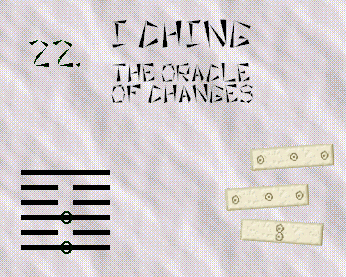

This software implements the ancient Chinese divinatory system of I Ching, or Book of Changes. The origin of the I Ching hexagrams date back more than 3000 years. Originally, during the Shang dynasty, the soothsayers used bones that were thrown into the fire. From cracks in the bones they were able to forecast the future. The broken and whole cracks are extant in I Ching as the whole lines (Yang), and the broken lines (Yin). A curiosity is that G.W. Leibniz (1646-1716) read a Latin version of the I Ching. It was then that he got the idea of the binary system. The hexagrams are actually binary representations, if the broken lines are understood as 0 and the whole lines as 1. The binary system is what underlies the computer age. Thanks to this invention Leibniz was able to design a computer, but he was never able to fabricate it.
To question the oracle you must throw the long dice six times. These dice have only two numbers: two and three. If the Yin numbers (the twos) are in majority then a Yin line (broken) will be produced. If the Yang numbers (the threes) are in majority, then a Yang line (whole) will be produced. Six throws are necessary to determine a hexagram. A hexagram consist of two trigrams. The headings "Above" and "Below" reflect upon these. Under the heading "The Lines" you can read what the strong lines mean. A strong Yin line (a "Six") has a cross on it. A strong Yang line (a "Nine") has a circle on it.
Under the hexagram number there appears a 'C'. There you can read the comments of King Wan and Duke of Kau. Whereas the hexagram text derives from the Wilhelm translation, the comments are taken from the Legge translation. This is an ideal combination. The comments in the Wilhelm translation are somewhat prosaic, which is not suitable for this spiritual book. Remember that the hexagram is more important than the commentators' texts. It is your associations that count, that is, it is you who should write the comment. This is also Palmer/Ramsay's standpoint in "I Ching - The Shamanic Oracle of Change" (1995).
I Ching contains much wisdom. It is well worth reading like a regular book. Its obscure language is typical for oracles (compare the oracle at Delphi, etc). Such obscure imagery can entice projections from the unconscious. It is well-known that the unconscious often carries solutions to our problems, as exemplified by the chemist Kekulé, who found the ring structure of benzene in a dream. A more prosaic explanation is that a comment of any sort has the capacity of breaking one's habitual thinking, and make one see things differently. Nigel Pennick, however, (Games of the Gods, 1988) argues that any divinatory system reflects upon the state of the universe at this very moment. He builds this notion on C.G. Jung's concept of synchronicity. Be that as it may, divinatory systems do actually work, one way or another.
The eight trigrams have the following names and symbolic meanings.








You can download my free I Ching program here (updated 2009-07-11), but you must own the software Zillions of Games to be able to run it (I recommend the download version).
© Mats Winther 2006